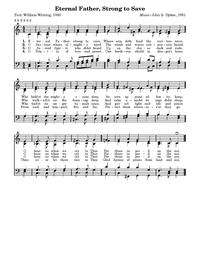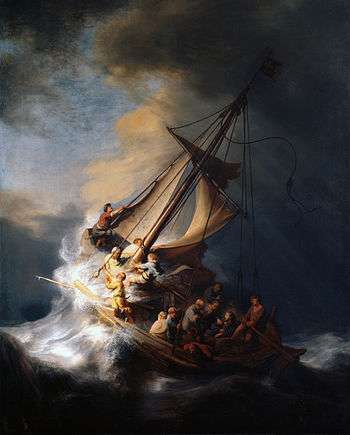Eternal Father, Strong to Save
 |
"Eternal Father, Strong to Save"
Sung by the US Navy Band Sea Chanters "Eternal Father, Strong to Save" (instrumental)
An instrumental sample of a single verse from Eternal Father, Strong to Save. |
| Problems playing these files? See media help. | |
"Eternal Father, Strong to Save" is a hymn traditionally associated with seafarers, particularly in the maritime armed services. Written in 1860, its author William Whiting was inspired by the dangers of the sea described in Psalm 107. It was popularised by the Royal Navy and the United States Navy in the late 19th century, and variations of it were soon adopted by many branches of the armed services in the United Kingdom and the United States. Services who have adapted the hymn include the Royal Marines, Royal Air Force, the British Army, the United States Coast Guard and the United States Marine Corps, as well as many navies of the British Commonwealth. Accordingly, it is known by many names, variously referred to as the Hymn of Her Majesty's Armed Forces, the Royal Navy Hymn, the United States Navy Hymn (or just The Navy Hymn), and sometimes by the last line of its first verse, "For Those in Peril on the Sea". The hymn has a long tradition in civilian maritime contexts as well, being regularly invoked by ship's chaplains and sung during services on ocean crossings.
Origin
The original hymn was written in 1860 by William Whiting, an Anglican churchman from Winchester, Great Britain. Whiting grew up near the ocean on the coasts of England, and at the age of thirty-five had felt his life spared by God when a violent storm nearly claimed the ship he was travelling on, instilling a belief in God's command over the rage and calm of the sea. As headmaster of the Winchester College Choristers' School some years later, he was approached by a student about to travel to the United States, who confided in Whiting an overwhelming fear of the ocean voyage. Whiting shared his experiences of the ocean, wrote the hymn to "anchor his faith".[1] In writing it, Whiting is generally thought to have been inspired by Psalm 107,[2] which describes the power and fury of the seas in great detail:
- Some went out on the sea in ships; they were merchants on the mighty waters.
- They saw the works of the Lord, his wonderful deeds in the deep.
- For he spoke and stirred up a tempest that lifted high the waves.
- They mounted up to the heavens and went down to the depths; in their peril their courage melted away.
- Psalm 107: 23–26
Within a year the text appeared in the influential first edition of Hymns Ancient and Modern (HA&M) in 1861 and its circulation became widespread throughout England.[3] The text was substantially revised by the compilers of that edition. In response Whiting continued to revise his own text, releasing another version in 1869 and third in 1874, the last one incorporating most of the suggested changes by HA&M.[4]
Meanwhile, John B. Dykes, an Anglican clergyman, composed the tune "Melita" to accompany the HA&M version of 1861. Dykes was a well-known composer of nearly three hundred hymn tunes, many of which are still in use today.[5] "Melita" is an archaic term for Malta, an ancient seafaring nation which has been a colony of the British Empire. It was the site of a shipwreck, mentioned in Acts of the Apostles (chapters 27–28), involving the Apostle Paul.
The original words of the 1861 version are:
|
|
Certain verses have been changed in modern hymnals for various reasons. The first verse refers to God the Father's forbidding the waters to flood the earth as described in Psalm 104. The second verse refers to Jesus' miracles of stilling a storm and walking on the waters of the Sea of Galilee. The third verse references the Holy Spirit's role in the creation of the earth in the Book of Genesis, while the final verse is a reference to Psalm 107.[6]
Navy use
The adoption of the hymn for devotional use and benedictions in the armed services was first recorded in 1879. In that year, Lieutenant Commander Charles Jackson Train was a navigation instructor at the United States Naval Academy at Annapolis and the master of the Midshipman Choir. Train began the practice of concluding Divine Services with the 1861 version of the hymn every Sunday, whereby it eventually became an academy, and then a service-wide, tradition, becoming known as the Navy Hymn. The lyrics were altered to suit changes in the culture and technology of the navy.[7] Additional variants have been written, often to specifically represent a particular branch of naval service.[8]
Adoption of the hymn by the Royal Navy may have occurred earlier than its use in the United States, though no clear records exist for when the hymn was first used. However, the hymn was in widespread use by the 1890s in the British naval services, though it was felt the text did not succinctly capture the experience of the navy enough and the wording has thus evolved. An extra verse was added during World War I to reflect the introduction of the Royal Naval Air Service.[9] The result today is a hymn somewhat different from its American counterpart, with the optional fifth verse for specific service branches being sung between the second and third verses.
Multiservice rewording
In 1940, the US Episcopal Church altered three verses of the hymn to include travel on the land in the second verse (referencing Psalm 50) and in the air in the third verse (again referencing Genesis). This was published as Hymn No. 513 while the original lyrics were also published as Hymn No. 512 in The Hymnal 1940. The Hymnal 1982, which is in current use by most Episcopal congregations in the US, has further revised this version (as Hymn #579) with opening line "Almighty Father, strong to save..." by adding the word "space" to the final verse, so it ends "Glad praise from space, air, land, and sea", acknowledging the possibility of space travel.[10] The Hymnal also has a more traditional water-only version (as Hymn #608) with opening line "Eternal Father, strong to save..."[11] The 1940 version—incorporating sea, land, and air is:
|
|
Stanzas 2–3 of the version in the 1940 Hymnal were written by the American bishop Robert Nelson Spencer (1877–1961) and published in 1937. The invasion of Army and Air Force lyrics into a hymn with which the Navy has had an historically almost proprietary relationship has been regarded as an instance, in interservice rivalry, of hymnological piracy.[12]
Other variants
Several additional or variant verses are in use in the US military services, including the Marines, Seabees, submariners and Coast Guard.[13]
|
Naval (General)
Ship Commissioning
Ship Decommissioning
Fliers
Submariners
Female Sailors
Military Families
|
United States Marines
Coast Guard
Navy SEALs
Navy Seabees
Doctors and Corpsmen
Astronauts
Arctic Exploration
|
Notable uses

This hymn was among those sung on 9 August 1941,[15] at a church service aboard the Royal Navy battleship HMS Prince of Wales attended by Winston Churchill (who requested that the hymn be sung) and Franklin D. Roosevelt at the conference creating the Atlantic Charter.[16] It was also disputably the last song sung during the Sunday Church Service on 14 April 1912 aboard the RMS Titanic, just hours before it sank.[17]
In the summer of 2009, the French frigate Latouche-Tréville D646 was filmed in stormy seas as part of the documentary Oceans.[18] A video was set to the Naval Hymn.
On 19 May 2012, it was the last hymn sung during the Church Service held upon a symbolic field of battle at Windsor Castle as part of the Armed Forces Tribute to the Commander in Chief of the combined services, HM Queen Elizabeth II. The Tribute marked her Diamond Jubilee.
Use in funerals
This hymn has been played or sung at a number of funerals for those who have served in or been associated with the US Navy. It was sung at the funeral of President Franklin D. Roosevelt, played by the Navy Band at the funeral of John F. Kennedy, sung at the funeral of Richard Nixon, and played by the Navy Band and the Coast Guard Band during the funeral of Ronald Reagan. Roosevelt had served as Assistant Secretary of the Navy, Kennedy was commanding officer of PT-109 in World War II, and Nixon served in the Navy during World War II in the Pacific Theater.[19] The hymn was also played to close the funeral of R. Buckminster Fuller, as well as at the Memorial Ceremony in Norfolk, Virginia, for the USS Cole after the bombing of the ship in October 2000. The hymn was also played at the funeral services of those killed among the crew of the USS Maine at the beginning of the Spanish–American War. It was performed by the US Navy Sea Chanters at the State Funeral of President Gerald R. Ford, who had served in the Navy during World War II in the Pacific Theater. The hymn was sung by the congregation at the funeral of news broadcaster Walter Cronkite at St. Bartholomew's Church in New York City. This was the last hymn sung at the funeral of Claude Choules, the penultimate living veteran from WWI, at his funeral in Fremantle, Western Australia on 20 May 2011.
References
- ↑ "Eternal Father, Strong to Save". Center for Church Music. Retrieved 14 June 2013.
- ↑ Osbeck, Kenneth W. (1985). 101 More Hymn Stories. Grand Rapids, MI: Kregel Publications. p. 81. ISBN 978-0825434204.
- ↑ Monk, William Henry (1861). Hymns Ancient and Modern. London, UK: Novello and Company.
- ↑ Glover, Raymond F. (1994). The Hymnal 1982 Companion. New York, NY: Church Hymnal Co. p. 608. ISBN 978-0898691436.
- ↑ Osbeck, Kenneth W. (1985). 101 More Hymn Stories. Grand Rapids, MI: Kregel Publications. p. 80. ISBN 978-0825434204.
- ↑ Osbeck, Kenneth W. (1985). 101 More Hymn Stories. Grand Rapids, MI: Kregel Publications. p. 81. ISBN 978-0825434204.
- ↑ ""Eternal Father, Strong to Save": The Navy Hymn". Naval History and Heritage Command. Retrieved 14 June 2013.
- ↑ "Eternal Father – The "Navy Hymn"". Department of the Navy. Retrieved 14 June 2013.
- ↑ "The Royal Naval Hymn". Retrieved 14 June 2013.
- ↑ Glover, Raymond F. (1994). The Hymnal 1982 Companion. New York, NY: Church Hymnal Co. p. 579. ISBN 978-0898691436.
- ↑ Glover, Raymond F. (1994). The Hymnal 1982 Companion. New York, NY: Church Hymnal Co. p. 608. ISBN 978-0898691436.
- ↑ "Eternal Father, Strong to Save" was sung at the 1963 funeral of President John Fitzgerald Kennedy, a United States Navy veteran of World War II.
- ↑ "Eternal Father, Strong to Save: The Navy Hymn". Naval Historical Center. 3 November 1997.
- ↑ http://www.cyberhymnal.org/htm/e/t/eternalf.htm, Retrieved 14 February 2012.
- ↑ Hal Buell, ed. (2006). World War II Album: The Complete Chronicle of the World's Greatest Conflict. New York City: Tess Press. p. 124. ISBN 1-57912-408-9.
- ↑ "W.G. Parker". Ohinemuri.org.nz. Retrieved 2 September 2011.
- ↑ Lord, Walter (1976). A Night to Remember. London: Penguin Books. ISBN 978-0-14-004757-8.
- ↑ "Oceans (2009)". Internet Movie Database. Retrieved 14 September 2015.
- ↑ Myers, Whitney V. (26 May 2008). "The Story Behind Eternal Father Strong to Save". Whitney Tunes.
External links
- "Eternal Father, Strong to Save" at CyberHymnal
- "Eternal Father, Strong to Save" at Oremus Hymnal
- US Navy FAQ on the Navy Hymn

